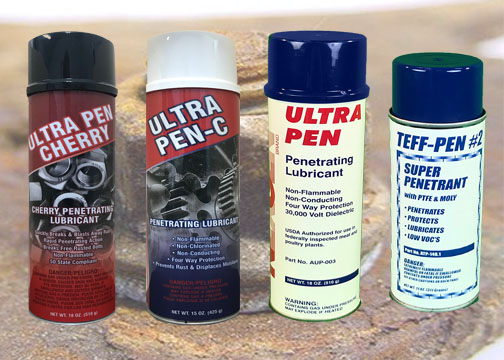Penetrants vs. Lubricants (Part 1)
Penetrating oils are used to free frozen nuts, bolts, locks, and other metal items that usually contain rust and corrosion. Lubricating oils are used to protect metal parts and keep them from becoming stuck in the first place. They are also used to quiet squeaks, noises and friction that come from metal parts rubbing together.
Today we are going to expand on penetrants, so be sure to keep an eye out for Part 2 in our next newsletter when we will go more in depth on lubricants.
What are penetrants or penetrating oils?
The main function of a penetrating oil is to loosen fasteners and metal parts that have corroded, seized or frozen due to exposure to the elements over time. Penetrating oils have a very low viscosity oil which allows it to flow easily between cracks, grooves and crevices to loosen corroded or rusted metal parts. Penetrating oils usually contain a mixture of a lubricant along with a solvent which thins the lubricant to increase its mobility. This mixture helps ensure it is thin enough to creep into the narrow spaces between parts allowing it to wash out elements like rust, corrosion and even dried out lubricants.
Your penetrant should do 3 things for you:
Displace Moisture
Penetrants should have the ability to disperse water, which results in preventing oxidation. If you want something to be low maintenance, then you should be looking to remove moisture. Moisture can be damaging and destructive. Penetrating oils can disperse water and prevent moisture from sitting in one place.
Inhibit Corrosion
A quality penetrating oil should contain a corrosion inhibitor which acts as a barrier against elements that can cause rusting and corrosion. They protect by filling any micro-spaces and pores before salt and grime has a chance to get in there and cause damage.
Lubricate to Loosen
In order to lubricate and help free frozen parts, a quality penetrant will cut through any grease or existing lubricant to get to the metal parts, in other words it will “seek out the metal”. The lubricating residue of a penetrant helps reduce heat, friction and noise between metal and rusted parts.
An additional safety measure is dielectric strength, or the maximum voltage it can handle before it breaks down and will no longer resist the passage of electric current. You will need a high dielectric strength when using penetrants where the fluid may be in contact with an electrical load, such as telecommunications or power transmission.
A penetrating oil can take anywhere from a few minutes to a few hours to work depending on the quality of the penetrant and what it is penetrating. The higher the quality the less time it will take to work saving you down time and lessening frustration and the possibility of breaking or damaging the substrate by trying to wrench the nuts loose.
Penetrating oils are also effective cleaning agents that can be used to remove tar, grease, and adhesives. This is due to the solvent content which acts as a cleaner or degreaser for dissolving contaminants. Once the fluid has mobilized the residue, it can then be wiped away.
Choosing a high quality industrial penetrant can save hours of time, and less product will be used to get better results than over the counter or lower quality penetrants. Saving a couple bucks up front could cost you dearly in the future.
Using a penetrating oil as general-purpose lubricant is not typically desirable. The mixture of solvent and oil is very thin and may evaporate in a shorter period of time. Higher quality penetrants perform a better lubricating function with a very small lubricating residue and are therefore more versatile.
Choosing the right lubricant for the job at hand can save time, money and more so join us for part 2 in our next newsletter!

